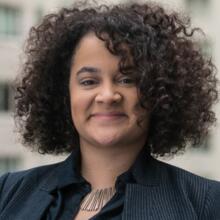On July 13, 2013, a jury acquitted George Zimmerman in the 2012 death of 17-year-old Trayvon Martin. Following the decision Alicia Garza, a community organizer and the Special Projects Director for the National Domestic Workers Alliance, expressed her outrage in a series of Facebook posts. She blamed institutional racism in the United States for placing “[Black] babies in cages and 6 feet under the ground” and refuted the often-cited claim that if communities of color were to “just do better for themselves” then the world would follow suit. Garza instead emphasized the critical need for collective action rather than individual empowerment.
Many of Ms. Garza’s social media posts contained the slogan “Black Lives Matter”; soon after the Martin trial, Ms. Garza, along with Patrisse Cullors and Opal Tometi, added a hashtag and the #BlackLivesMatter movement began.
The founders define the movement as “a collective affirmation and embracing of the resistance and resilience of Black people.” They add that “it is a reminder and a demand that [Black] lives be cherished, respected and able to access…full dignity and determination.” Members of #BlackLivesMatter also protest against police brutality, racial profiling, economic inequality and the mass incarceration of people of color.
Since its inception the #BlackLivesMatter movement has grown worldwide, with over 20 chapters in Canada, Ghana and the United States. As of 2015, there have been over 500 demonstrations.
In its two years, as the movement continues growing, so does the list of protested deaths. The movement has received impetus from the deaths of Michael Brown, Eric Garner and Tamir Rice, just to name a few. As this list grows, so does the fervor behind #BlackLivesMatter.
In an interview with The Feminist Wire, Ms. Garza reiterated the need for the movement, citing the disproportionate state violence black Americans face within the United States. She emphasized, “When Black lives get free, everybody gets free.”
As the movement reaches its two-year anniversary, let us analyze its evolution.
The Faces of the Movement
Social media has played a large role in the growth of the #BlackLivesMatter movement. With platforms like Facebook, Twitter and Tumblr, activists across the United States and worldwide are able to connect with fellow activists, reporters and even media organizations.
As the movement grows on social media, certain activists have become the face of the movement. Two of these activists are Deray McKesson and Johnetta Elize.
Mr. McKesson, a former school administrator from Minnesota, left his job in March and moved to St. Louis to become a full-time activist. Ms. Elize, originally from the St. Louis area, became involved in the movement following the death of Michael Brown. (Both were recently named on Fortune’s “World’s 50 Greatest Leaders,” a list that includes names like Bill Gates, Taylor Swift and Pope Francis.)
In a recent interview with The New York Times, Mr. McKesson and Ms. Elize describe the power behind the movement. McKesson states that “the heart of the movement is in actions…in shutting down streets.” He adds that the goal is to “make people feel as uncomfortable as we feel when we hear about Mike [Brown], about Eric Garner, about Tamir Rice.”
Elize adds, “Our demand is simple: Stop killing us.”
Certain organizations have also become a part of the #BlackLivesMatter movement. One in particular is Justice League N.Y.C. The J.L.N.Y.C. is “a task force of juvenile and criminal justice advocates, artists and experts, and formerly incarcerated individuals, brought together under the banner of The Gathering for Justice”—a civil rights organization formed by Harry Belafonte in 2005. The Justice League is currently under the leadership of Carmen Perez, the executive director of The Gathering for Justice.
In a phone interview last month, I spoke with Ms. Perez about her work with the J.L. and its involvement in the movement. She describes the J.L.’s involvement in #BlackLivesMatter as occurring organically because many of the issues which the organization protests—racial profiling, police brutality, mass incarceration—disproportionately affect African Americans and other communities of color. “Those that are being killed by police every 28 hours are black people and if we understand that black lives matter, then we will all be upgraded,” Ms. Perez adds.
The Presence of Faith
In our interview, Ms. Perez describes the presence of religious leaders in the movement, a much-valued authority within activist circles. “It is important for religious communities to understand that there is a role for them and that we welcome their participation,” Ms. Perez states.
On June 10, the United States Conference of Catholic Bishops also released a statement on U.S. race relations. In it, the president of the U.S.C.C.B., Archbishop Joseph E. Kurtz of Louisville, Ky., mourned the deaths that have occurred at the hands of police officers in recent years and commended the peaceful protests that have occurred across the United States.
Kurtz emphasized the need to address the causes of institutional racism and provided concrete ways in which all communities can fight to end racism: praying; studying Catholic social teaching; encountering individuals from different racial backgrounds; involvement from parishes in local communities; and positive relationships between communities and police departments.
In its two years, the #BlackLivesMatter movement has helped further the race conversation in the United States. It will continue to provide amplified focus on issues that affect people of color both here in the United States and the world. As the movement enters its third year, there is still much ground to cover. In the words of Archbishop Kurtz, “Sadly, the present racial tension in the United States is nothing new. It is the most recent manifestation of a relationship as old as the history of our nation, one marred by the tragedy of human slavery. Promoting peace and reconciliation is the only way forward.”








